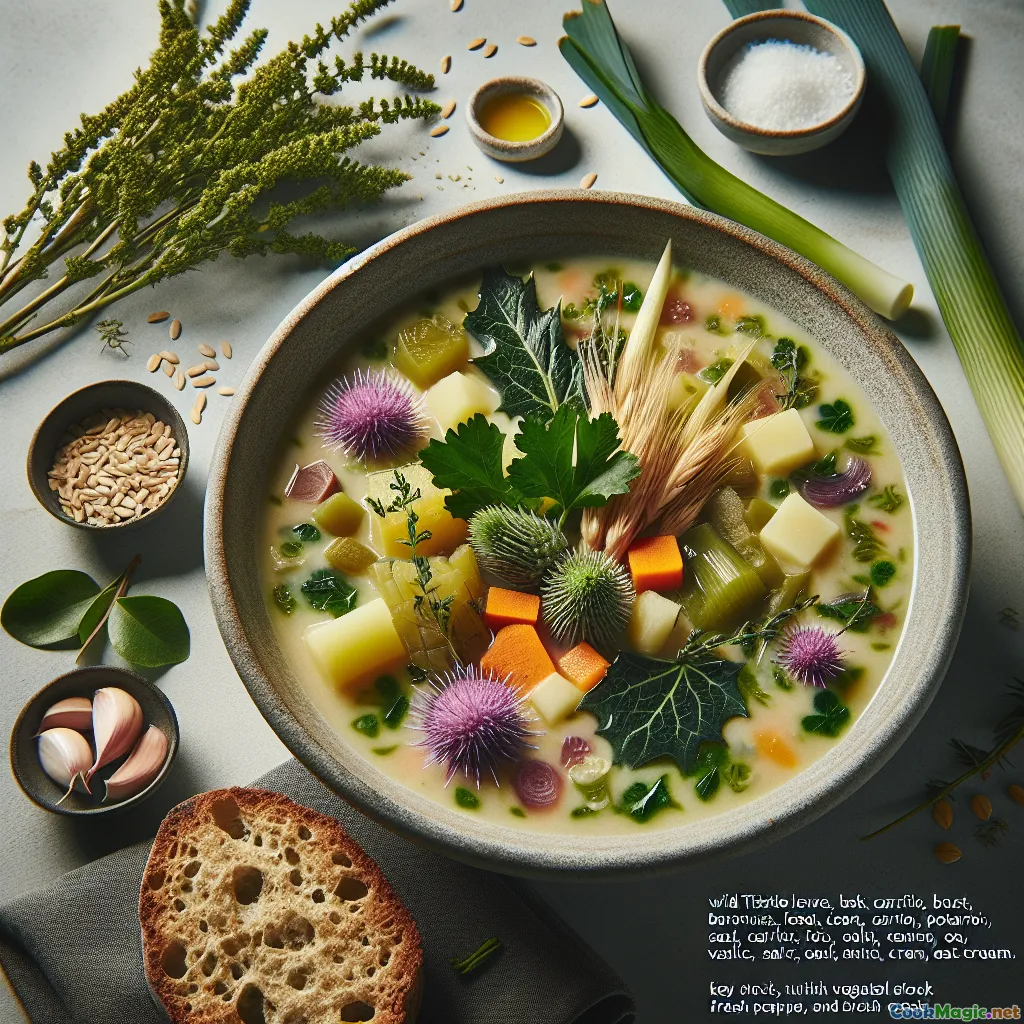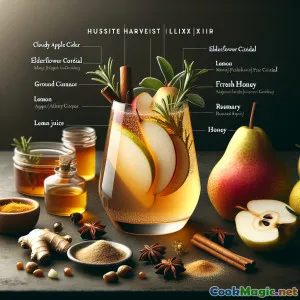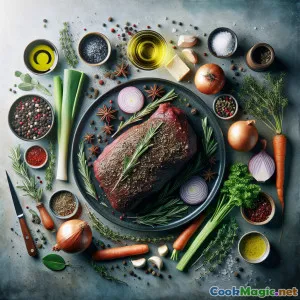
丰盛的苏格兰蓟草与根菜汤
(Hearty Scottish Thistle & Root Vegetable Soup)
(0 评论)食材
-
100 grams 野生蓟叶
(浸泡并去除刺;来自安全、无农药区域的嫩蓟是理想选择)
-
80 grams 大麦粒
(推荐珠粒大麦)
-
1 medium 大葱
(洗净并切片)
-
2 medium 胡萝卜
(切丁)
-
1 medium 欧防风
(切丁;增添正宗高地的甜味)
-
1 large 土豆
(去皮并切成方块)
-
1200 ml 蔬菜高汤
(可以用非素食版本的鸡肉高汤代替)
-
2 cloves 大蒜
(切得很细)
-
3 sprigs 新鲜百里香
(或1茶匙干百里香)
-
1 tsp 盐
-
0.5 tsp 黑胡椒
(建议使用新鲜现磨)
-
60 ml 燕麦奶油
(增加奶油感,如喜欢可使用乳制品奶油)
-
2 tbsp 新鲜欧芹
(切碎,作为装饰)
-
4 slices 班诺克面包
(传统的苏格兰配菜)
(浸泡并去除刺;来自安全、无农药区域的嫩蓟是理想选择)
(推荐珠粒大麦)
(洗净并切片)
(切丁)
(切丁;增添正宗高地的甜味)
(去皮并切成方块)
(可以用非素食版本的鸡肉高汤代替)
(切得很细)
(或1茶匙干百里香)
(建议使用新鲜现磨)
(增加奶油感,如喜欢可使用乳制品奶油)
(切碎,作为装饰)
(传统的苏格兰配菜)
营养
- 份量: 4
- 每份大小: 1碗(300ml)
- Calories: 210 kcal
- Carbohydrates: 38 g
- Protein: 6 g
- Fat: 3 g
- Fiber: 8 g
- Sugar: 7 g
- Sodium: 650 mg
- Cholesterol: 0 mg
- Calcium: 74 mg
- Iron: 2.1 mg
制作步骤
-
1 - 准备野生蓟:
戴手套,仔细修剪蓟草叶。去除刺和木质茎。在冷盐水中浸泡10分钟,然后冲洗并撕碎。
-
2 - 切菜:
将胡萝卜、欧洲防风和土豆切成丁。将大葱切片,蒜末,准备好剩余的所有蔬菜。
-
3 - 炒底料:
在一个厚底锅中用中火,加一点油。炒葱和大蒜2-3分钟,直到散发出香味。
-
4 - 烹饪蔬菜:
加入胡萝卜、欧洲防风和土豆。搅拌煮5分钟,直到边缘变软。
-
5 - 小火炖汤:
倒入蔬菜高汤。加入大麦、蓟、百里香、盐和胡椒。用小火炖30-35分钟,偶尔搅拌,直到大麦和蔬菜变软。
-
6 - 完成并混合:
为了做出奶油汤,用手持搅拌器打碎一半的混合物。想要粗糙的质地,可以保留块状。
-
7 - 装饰和上菜:
加入燕麦奶油以增加浓稠度(可选)。用切碎的欧芹装饰。热食,搭配一片班诺克面包。
戴手套,仔细修剪蓟草叶。去除刺和木质茎。在冷盐水中浸泡10分钟,然后冲洗并撕碎。
将胡萝卜、欧洲防风和土豆切成丁。将大葱切片,蒜末,准备好剩余的所有蔬菜。
在一个厚底锅中用中火,加一点油。炒葱和大蒜2-3分钟,直到散发出香味。
加入胡萝卜、欧洲防风和土豆。搅拌煮5分钟,直到边缘变软。
倒入蔬菜高汤。加入大麦、蓟、百里香、盐和胡椒。用小火炖30-35分钟,偶尔搅拌,直到大麦和蔬菜变软。
为了做出奶油汤,用手持搅拌器打碎一半的混合物。想要粗糙的质地,可以保留块状。
加入燕麦奶油以增加浓稠度(可选)。用切碎的欧芹装饰。热食,搭配一片班诺克面包。
关于 丰盛的苏格兰蓟草与根菜汤 :的更多信息
Eastern Highland Thistle Soup: Wild Virtues in a Bowl
The Eastern Highland Thistle Soup offers a unique taste of Scottish ingenuity, steeped in tradition and brimming with nutrients extracted from the land itself. There’s something magical about using wild ingredients — and in Scotland’s rugged, mist-shrouded highlands, it doesn’t get wilder or more iconic than the humble thistle. Long revered as the national emblem, thistle is rarely found in contemporary kitchens, but historically, resourceful cooks and foragers transformed it into sustenance during lean seasons.
History & Tradition
The thistle has been wreathed in Scottish legend for centuries, celebrated not just as a hardy symbol but as an edible plant that once joined nettle and dandelion on rural tables. Our ancestors prized these wild greens, leveraging their strong flavors and abundant nutrition to survive both harsh winters and dietary restrictions, especially in times when fresh greens from the garden were unavailable. While challenging to harvest and often overlooked due to its natural armor of spiny thorns, careful preparation renders the young thistle a surprisingly delicate, herbal addition to soups.
Barley grain links this recipe firmly to Scottish culinary roots, as barley fields once blanketed the highlands and valleys, providing both warmth and energy to crofters and city folk alike. Blending the earthy root vegetables with the clean, slightly artichoke-esque notes of young thistle strikes a remarkable balance between comfort and novelty.
Preparation & Cooking Notes
When foraging for thistle, choose young plants with pliable, green leaves. Always wear gloves to avoid painful pricks! After thorough cleaning and de-thorning (a tedious but meditative step), even the cautious cook will appreciate thistle’s ability to absorb the flavors of companion vegetables. Soaking the leaves in cold salted water not only reduces bitterness but also revives any wilt.
The base of sautéed leeks and garlic creates deep aromatics, feeding the barley and root vegetables with subtlety. Each addition—carrots for sweetness, parsnips for a honeyed hint, and potatoes for rich body—grounds the soup in hearty comfort. The barley slowly swells, lending creamy thickness and transforming each mouthful into an edible embrace against cold Highland winds.
Blending a portion of the soup isn’t obligatory; many prefer to leave it rustic and toothsome, with surprising green flecks and pockets of chewy barley. If you fancy a more modern, delicate texture, a partial blend is a happy compromise.
Personal Tips & Serving Suggestions
- Ensure thistle is from an uncontaminated, reliable foraging site to avoid exposure to harmful chemicals.
- Oat cream is an excellent vegan alternative that echoes both regional ingredients and contemporary dietary needs. Classic single cream works beautifully for a more luxurious mouthfeel, though lent creamy richness may overshadow the delicate meadow notes of thistle.
- Leftovers keep splendidly and actually develop greater flavor after a rest in the cold; simply reheat gently, perhaps with extra fresh herbs to liven things.
- Bread accompaniment is tradition-hard to break—opt for dense, slightly sweet Scottish bannock or freshly toasted oatcakes.
Cultural Significance & Uniqueness
In cultural terms, there’s exceptional pride packed into a bowl of this soup. Every spoonful is layered with the spirit of Scottish resilience—the making-do, the refusal to waste, the transformation of prickly obstacles into nourishment. Though thistle’s notoriety as a weed might scare the home chef, its place in sustainable, foraged cooking cannot be overstated as lawns and fields around the world gain interest for their wild bounty.
Sharing Eastern Highland Thistle Soup carries the stories of foragers past into modern kitchens. Its uncommon green hue, delicate herbal perfume, and gentle sweetness from familiar roots evoke a culinary landscape many have never tasted—but will remember.
Dreamy, elemental, and bravely botanical, this is a dish for those who don’t just want to taste a meal, but to experience the landscape from which it springs. Try it with friends who crave adventure, and enjoy a rare Scottish tradition reborn.
























